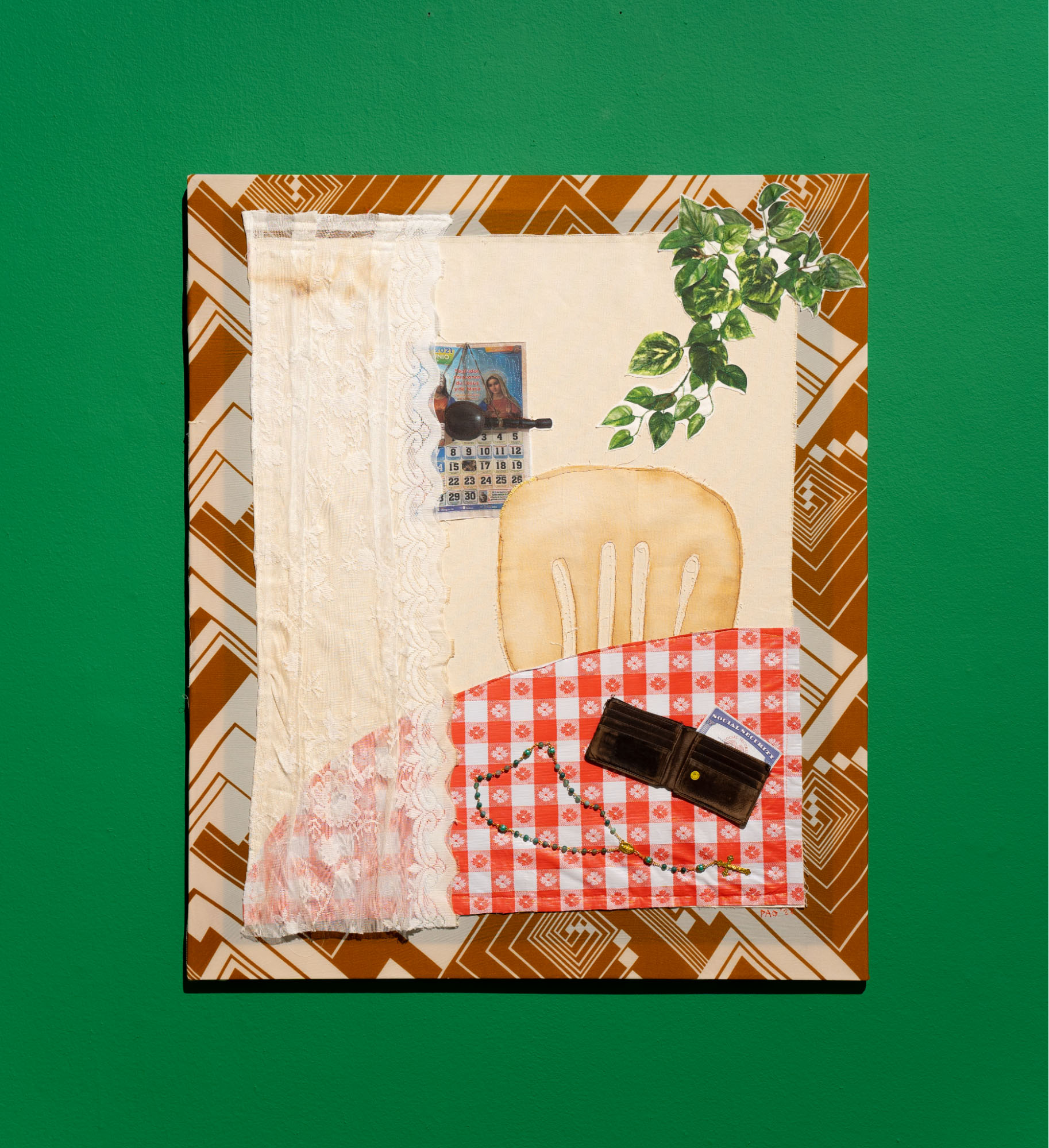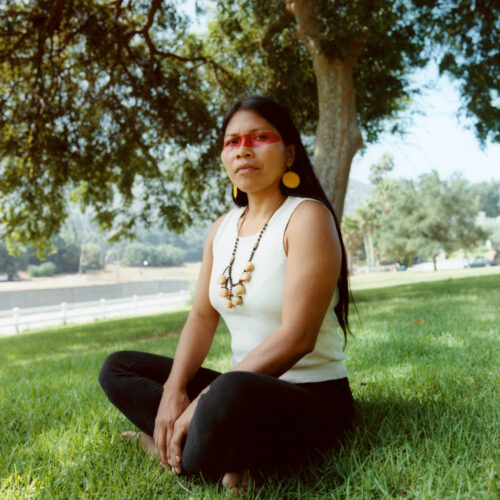Banana trees and calling cards are some of the motifs of Paola De La Calle’s largest body of work to date, spanning across ceramics, textiles, installation, and sound, In This House We Are All Buried Alive, runs through August 27th at San Francisco’s SOMArts.
In her debut solo exhibition, De La Calle conjures memories of her childhood, family migration, and Colombia. For the multimedia visual artist, everyday objects are imbued with stories, memories, and history. In De La Calle’s words, “Objects can be sort of like portals through space and time.” She transforms quotidian imagery and instills new meaning to fill in the gaps of historical amnesia, or the parts of the past we tend to forget. In doing so, she quietly bridges the distance between history and personal memory.
De La Calle grew up in the greater Boston Area before relocating to San Francisco in 2017. Since then she’s completed various residencies including the New York Foundation of the Arts Immigrant Artist Program and the KALA Art Institute Print Fellowship. While her family migrated to the States from Colombia in the eighties, the connections across time and diaspora reverberate through De La Calle’s practice today. “I spent a lot of my childhood both living and traveling back to Colombia, even though I was born [in the United States]. I consider [that] to be a really big privilege — to be able to have this conversation across borders, across countries.”
View this post on Instagram
She’s used the privilege of citizenship to investigate notions of home, borders and identity in her artmaking. In 2021, she was the lead artist for Caravan for the Children, a campaign demanding the “Release, Reunification and Healing of migrant children” in ICE custody. The works she made then were focused on extending herself outward and collaborating with other artists and organizations, a compassionate reach toward those whose lives continue to be in jeopardy.
In In This House We Are All Buried Alive, De La Calle looks inward. She investigates how the social-political histories of the United States and Colombia shape family narratives, influence identity, and transform cultural memory. She does so by centering her own diasporic experience. “I think this work is deeply personal in a way that my work hasn’t been before. Before, I was talking about events: historical moments or social movements. Now I’m really thinking about the ways that these historical moments, things that we learn about, affect the personal,” De La Calle explains.

Installation view, In This House We Are All Buried Alive, SOMArts, 2023. Photo courtesy of Claire S. Burke.
The result is a generous exhibition where De La Calle shares sacred and private vignettes of migration in order to humanize history. Held at SOMArts in San Francisco, the exhibition features an array of recent collage, textile and sculptural works that interweave personal and historical archives. One of her most striking works is the centerpiece Hanging Archive, a series of printed chiffon ribbons ranging from 15 to 42 feet in length which are hung from the rafters of the main gallery. In it, De La Calle juxtaposes printed WhatsApp messages and screenshots from Google Map searches with embroidered first-person accounts of Spanish colonization and the War on Drugs. While they may not seem like it at first, in putting this imagery alongside “official” archives De La Calle reminds us how these mobile apps can serve as repositories for memories, just like institutional archives.

Paola De La Calle, For Our Words to Travel When We Couldn’t (Magic Carpet). Photograph by Jesus Rodriguez for SOMArts Cultural Center.
Like Hanging Archive, many of De La Calle’s works reference the role that modes of communication have in creating memories across borders and time. To this effect, calling cards are referenced throughout the exhibition. In For Our Words to Travel When We Couldn’t (Magic Carpet) a hanging textile takes the form of an Orbitel card – a popular Colombian prepaid calling card used in the pre-WhatsApp era. Whereas Orbitel cards are pocket size and feature a generic slew of promotional photos like families hugging and colonial churches, De La Calle’s calling card is 4 feet tall and features a patchwork of her own photography. In this piece, she compiles images of a banana field, clay roof tiles, and home video stills featuring a child (her sister) on the phone and another blowing birthday candles. The card has a shiny fringe at the bottom, referencing the work’s title; though separated by distance and borders, the card miraculously acts as a magic carpet that allows loved ones to share tender moments by proxy.

Paola De La Calle, Sobremesa (o La Silla del Abuelo en Barrio San José). Photograph by Jesus Rodriguez for SOMArts Cultural Center.
For De La Calle, among the most exciting elements in her latest work is incorporating natural materials. “Material is really important for me, [as is] making sure that the material goes hand in hand with the message,” she shared. On that note, the artist worked with coffee-based ink to create watercolor recreations of old family photographs. It’s a natural connection to her roots for De La Calle, as coffee is both a reminder of home and a historically charged relic. As a motif in De La Calle’s work, it alludes to intimate familial moments over warm coffee, when stories are passed down and jokes are shared, as seen in Sobremesa (o La Silla del Abuelo en Barrio San José) [Abuelo’s Chair in Barrio San José]. In both subject and material, De La Calle invites us to understand how coffee can inspire a collective remembrance.

Paola De La Calle, Religion, Cafe y Banano (Roban y Regalan Bala). Photograph by Jesus Rodriguez for SOMArts Cultural Center.
In other artworks, coffee represents Colombia’s largest commodity. In this context, coffee refers to the extractive relationship between the USA and Colombia and colonialism at large. De La Calle addresses this head-on in Religion, Cafe y Banano (Roban y Regalan Bala) [Religion Coffee, Bananas, (They Rob Us and Gift Us Bullets)], a collage where coca leaves turn into bullets as they pour down. Below them, staples of Colombian life lay waiting to be struck – a bunch of Chiquita bananas, an espresso cup, and a palm Sunday cross. The artwork, De La Calle explained, is simultaneously an “investigation on the War on Drugs and its impact on migration, the displacement of campesinos, and increased violence in Colombia.”
Though Paola De La Calle’s work is deeply personal and the point of reference for migration is Colombia, she invites viewers to find their own connections regardless of where they consider home to be. “Anytime someone can point to something physical that I collected and are able to attach their own memories to it, that’s [when I think], ‘yes, it’s doing what I wanted it to do,” notes the artist.

Photograph by Stephanie Cherry Ayala
There are countless connections to be made in In This House We Are All Buried Alive. De La Calle translates history into enfleshed experiences, showing us how everyday objects can provoke melancholy, joy, and longing for a homeland far away. There are infinite bridges to memory, although she knows that memory is not synonymous with truth: “The way that we remember things might not be the way that they were” she admits.
De La Calle’s work, a masterful blending of the personal with the global, ignites a collective memory which inspires us to pick up the leftover pieces of our own histories in order to shape and tell our stories.
Joanna García Cherán is an art historian, writer and cultural worker passionate about art of our time.










